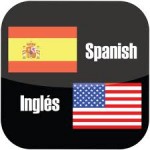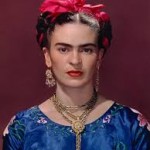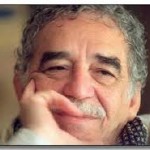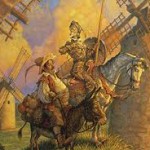There’s an app for literally everything these days and Spanish dictionaries are no exception. But how do today’s apps ![]() measure up against the long-established paper dictionary that has been the language students’ trusty companion for generations? We examine the pros and cons of each.
measure up against the long-established paper dictionary that has been the language students’ trusty companion for generations? We examine the pros and cons of each.
The app wins hands down on portability and convenience. With no books to carry around and a large vocabulary at your fingertips, the Spanish app is certainly a very useful tool for anyone learning the language. They’re great for speedily looking up the odd word that you might have forgotten while you’re on the go, and they’re invaluable when you’re travelling to a Spanish-speaking country and don’t want to use up your baggage allowance with heavy reference books.
Some apps even include a voice recognition feature, which can be handy when you don’t know how to spell a word or you’re trying to have a conversation with someone and are struggling to understand something they are saying. However, these features don’t always accurately capture the words being spoken, particularly if there is a lot of background noise.
We do find though that most apps can’t yet compete with the breadth and depth of information contained in a paper dictionary, and the traditional dictionary tends to fare much better when it comes to giving in-depth definitions and examples of the usage of words in different contexts. Apps are developing all the time and have some exciting capabilities which are sure to get even better in the future, and in our opinion every tool that can help in any small way when you are learning Spanish is a force for good, so our advice is make the most of them, but don’t throw your dictionaries away just yet.
 completely ingrained. It’s understandable then that when we start to learn another language, we try to apply the rules we already know to it. This doesn’t work though, as we frequently (but patiently!) have to explain to students.
completely ingrained. It’s understandable then that when we start to learn another language, we try to apply the rules we already know to it. This doesn’t work though, as we frequently (but patiently!) have to explain to students. exponents of Latin music of the 20th century, earning twenty-three gold albums during the course of a long and illustrious career. She was born in Havana in 1925 and was the second child of Simon Cruz and Catalina Alfonso.
exponents of Latin music of the 20th century, earning twenty-three gold albums during the course of a long and illustrious career. She was born in Havana in 1925 and was the second child of Simon Cruz and Catalina Alfonso. the most successful crossover Latin musician ever, with seven Grammy awards and 100 million record sales to her name. Gloria María Milagrosa Fajardo García de Estefan was born in September 1957 in Havana, Cuba. Have you ever wondered at the lengthy names quoted in our biographical blogs? These follow Spanish naming customs where the paternal name (Fajardo) is given first and the maternal family name (Garcia) second. ‘de Estefan’ was added after her marriage in 1978 to Emilio Estefan.
the most successful crossover Latin musician ever, with seven Grammy awards and 100 million record sales to her name. Gloria María Milagrosa Fajardo García de Estefan was born in September 1957 in Havana, Cuba. Have you ever wondered at the lengthy names quoted in our biographical blogs? These follow Spanish naming customs where the paternal name (Fajardo) is given first and the maternal family name (Garcia) second. ‘de Estefan’ was added after her marriage in 1978 to Emilio Estefan. lifelong health problems, and these contributed to the “pain and passion” she displayed in her works. She is probably best known for her self-portraits, a result of the isolation enforced on her by her poor health. As she herself said, “I paint myself because I am so often alone and because I am the subject I know best”. Though she is sometimes referred to as a surrealist painter, Kahlo refuted this, saying, “They thought I was a surrealist, but I wasn’t. I never painted dreams. I painted my own reality”.
lifelong health problems, and these contributed to the “pain and passion” she displayed in her works. She is probably best known for her self-portraits, a result of the isolation enforced on her by her poor health. As she herself said, “I paint myself because I am so often alone and because I am the subject I know best”. Though she is sometimes referred to as a surrealist painter, Kahlo refuted this, saying, “They thought I was a surrealist, but I wasn’t. I never painted dreams. I painted my own reality”. in Aracataca, Colombia in March 1927, his full name is Gabriel José de la Concordia García Márquez, though he is known throughout the Latin American world simply as ‘Gabo’, a mark of the great affection in which he is held.
in Aracataca, Colombia in March 1927, his full name is Gabriel José de la Concordia García Márquez, though he is known throughout the Latin American world simply as ‘Gabo’, a mark of the great affection in which he is held. commercial success with novels such as La Casa de los Espiritus (The House of the Spirits) and La Ciudad de las Bestias (City of the Beasts) among her many published works.
commercial success with novels such as La Casa de los Espiritus (The House of the Spirits) and La Ciudad de las Bestias (City of the Beasts) among her many published works. Pablo Neruda who is hailed as one of the most important poets of the 20th century. Born Neftali Ricardo Reyes Basoalto in 1904, Neruda was something of a prodigy, having composed his first poems at the age of ten and been published by the time he reached his early teens.
Pablo Neruda who is hailed as one of the most important poets of the 20th century. Born Neftali Ricardo Reyes Basoalto in 1904, Neruda was something of a prodigy, having composed his first poems at the age of ten and been published by the time he reached his early teens. greatest works of literature ever written in any language. Its full title in Spanish is El ingenioso hidalgo don Quijote de la Mancha, or The Ingenious Gentleman Don Quixote de la Mancha. The novel by Cervantes follows the adventures of Alonso Quijano, who reinvents himself as Don Quixote and embarks on a quest to revive chivalry, accompanied by his squire, Sancho Panza.
greatest works of literature ever written in any language. Its full title in Spanish is El ingenioso hidalgo don Quijote de la Mancha, or The Ingenious Gentleman Don Quixote de la Mancha. The novel by Cervantes follows the adventures of Alonso Quijano, who reinvents himself as Don Quixote and embarks on a quest to revive chivalry, accompanied by his squire, Sancho Panza.